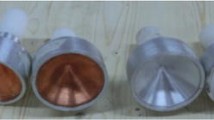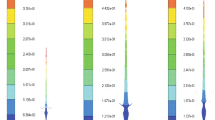Abstract
In order to develop a tandem warhead that can effectively destroy concrete targets, this paper explores the penetration performance of shaped charges with different cone angles and liner materials into concrete targets by means of experiments. The penetration process and the destruction mechanism of concrete targets by shaped charges and kinetic energy projectiles are analyzed and compared. Experimental results suggest that both kinetic energetic projectile and shaped charge are capable of destroying concrete targets, but the magnitudes of damage are different. Compared with a kinetic energy projectile, a shaped charge has more significant effect of penetration into the target, and causes very large spalling area. Hence, a shaped charge is quite suitable for first-stage charge of tandem warhead. It is also found that, with the increase of shaped charge liner cone angle, the depth of penetration decreases gradually while the hole diameter becomes larger. Penetration depth with copper liner is larger than of aluminum liner but hole diameter is relatively smaller, and the shaped charge with steel liner is between the above two cases. The shaped charge with a cone angle of 100° can form a jet projectile charge (JPC). With JPC, a hole with optimum depth and diameter on concrete targets can be formed, which guarantees that the second-stage warhead smoothly penetrates into the hole and explodes at the optimum depth to achieve the desired level of destruction in concrete targets.
Similar content being viewed by others
Explore related subjects
Discover the latest articles and news from researchers in related subjects, suggested using machine learning.References
Tham, C.Y.: Reinforced concrete perforation and penetration simulation using AUTODYN-3D. Finite Elem. Anal. Des. 41, 1401–1410 (2006)
Ning, J.G., Song, W.D., Wang, J.: A study of the perforation of stiffened plates by rigid projectiles. Acta Mech. Sin. 21, 582–591 (2005)
Chen, X.W., Li, X.L., Chen, Y.Z., Wu, H.J., Huang, F.L.: The third dimensionless parameter in the penetration dynamics of rigid projectiles. Chin. J. Theor. Appl. Mech. 39(1), 77–84 (2007)
Heider, N.: Numerical simulation of the performance of tandem warheads. In: 19th International Symposium on Ballistics, Interlaken, Switzerland, pp. 1329–1334 (2001)
Walters, W.P., Zukas, J.A.: Fundamentals of Shaped Charges. Wiley, New York (1989)
Huerta, M., Vigil, M.G.: Design, analyses, and field test of a 0.7 m conical shaped charge. Int. J. Impact Eng. 32(8), 1201–1213 (2006)
Murphy, M.J., Randers-Pehrson, G., Kuklo, R.M. et al.: Experiments and simulations of penetration into granite by an aluminum shaped charge. J. Phys. IV 110, 603–608 (2003)
Wang, H.: Research on Effects of Shaped Charge Penetrating into Concrete Medium. PhD dissertation, Beijing Institute of Technology, Beijing (1997)
Heider, N.: Numerical simulation of the penetration process of geopenetrators onto predamaged concrete targets. In: Proceedings of 20th International Symposium on Ballistics, Orlando, pp. 1167–1174 (2002)
Resnyansky, A.D., Wildegger-Gaissmaier, A.E.: Study of the borehole diameter in Concrete due to the shaped charge jet penetration. In: Proc. of 20th International Symposium on Ballistics, Orlando, pp. 1167–1174 (2002)
Kozachuk, A.I., Kozhushko, A.A., Rumyantsev, B.V. et al.: On interaction of shaped charge jets with the crater walls in penetrating metals and brittle materials. Int. J. Impact Eng. 29, 385–398 (2003)
Chen, X.W., Zhang, F.J., Yang, S.Q. et al.: Mechanics of structural design of EPW (III): Investigations on the reduced-scale tests. Explosion Shock Waves 26(2), 105–114 (2006)
Wang, C.: Experiment and numerical simulation of deep penetration of large diameter and multi-layer metal target. PhD dissertation, Beijing Institute of Technology, Beijing (2001)
Zhang, L.L.: Study on jetting projectile charge penetration to concrete. PhD dissertation, Beijing Institute of Technology, Beijing (2006)
Author information
Authors and Affiliations
Corresponding author
Additional information
The project supported by the National Natural Science Foundation of China (10625208).
Rights and permissions
About this article
Cite this article
Wang, C., Ma, T. & Ning, J. Experimental investigation of penetration performance of shaped charge into concrete targets. Acta Mech Sin 24, 345–349 (2008). https://doi.org/10.1007/s10409-008-0160-3
Received:
Revised:
Accepted:
Published:
Issue Date:
DOI: https://doi.org/10.1007/s10409-008-0160-3




